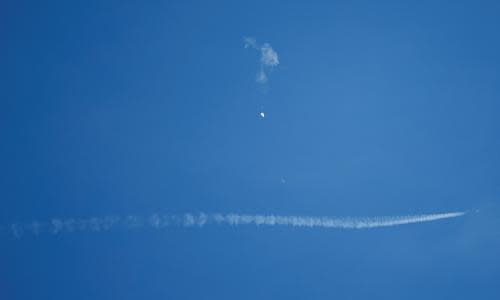Now the Chinese ‘spy balloon’ is down, the question is: what was it for?
- Oops!Something went wrong.Please try again later.
- Oops!Something went wrong.Please try again later.

Now the Chinese balloon has been brought down in a puff of smoke and debris by a US air-launched missile, after perplexing Washington with its three-day odyssey over the continental US, the question is: what was it all for?
Once the balloon was spotted, Beijing claimed it was a weather observation airship that had been blown off course, drawing a snort of derision from the Pentagon, which said the balloon was able to manoeuvre and had made some deliberate turns, bringing it at one point over Montana, home of some of the US arsenal of silo-based nuclear intercontinental ballistic missiles (ICBMs).
Related: US shoots down suspected Chinese spy balloon over east coast
If it was indeed a spy balloon, the whole episode raises a lot of questions about decision-making in Beijing. It was quite predictable that the balloon would be spotted, tracked and even shot down, and that all this would happen in the run-up to a visit by the secretary of state, Antony Blinken, to Beijing.
That visit had been welcomed by Xi Jinping, who intended to meet America’s top diplomat, and the talks were meant to address a series of serious potential flash points between the two superpowers, most importantly the future of Taiwan.
Either this was a case of the left hand not knowing what the right was doing, or it was possibly a deliberate attempt to sabotage any tension-soothing the Blinken trip might have achieved.
Another question is technical. Why send a balloon to do your spying in an age of satellites? Balloons are cheaper and can get closer to surveillance targets. However, it is unclear what a balloon could see in the missile silos of Montana that was not already known to the Chinese.
The Pentagon did not seem over worried about what the balloon may have seen, and claims to have been able to block at least some of its intelligence collection, while turning the tables by studying the balloon and its payload.
Perhaps the intention was to monitor the military response, to see how soon the balloon would be spotted and how quickly fighter jets would be scrambled.
The political response may also be interesting to Beijing. According to Pentagon officials, China sent three balloons over US territory during the Trump administration, without a military response, although those earlier flights do not appear to have traversed nearly so much US territory. Beijing was possibly testing Biden’s mettle.
Balloons are certainly better than satellites at rattling the targeted country, and caused a minor political storm in the US, with Republicans calling for the balloon to be immediately shot down over land, despite the risk of deaths and property damage below.
The Biden administration will now have to test Beijing’s response in an effort to gauge the intentions behind the overflight. It will soon be able to approach the Chinese government in possession of the balloon’s payload and an understanding of its technology.
So far, China has stuck to its story that it was a weather balloon and that the use of force was a “clear overreaction and a serious violation of international conventions”.
The switch from contrition to indignation will make it harder for Beijing to stand down. China may well demand the immediate return of the wreckage without US scrutiny, as Washington unsuccessfully tried when one of its spy planes was forced to land on China’s Hainan island in April 2001, causing a diplomatic crisis until the crew, and later the disassembled aircraft, were returned.
It was with one eye on potential legal disputes that the US air force made sure it downed the balloon over US territorial waters.
“I expect that the US will attempt to promptly retrieve the balloon to ascertain why it was flying across the country,” said Carl Tobias, a University of Richmond law professor. “If the US finds that the balloon was engaged in surveillance of America, the PRC would have difficulty in demanding its return.”
Some US pundits argued that Blinken should have flown to Beijing regardless, to use the shooting down of the balloon as an illustration of Washington’s resolve. Others said he was right to postpone, as the furore would have crowded out everything else on the very full and urgent bilateral agenda. No new date has been set for the Blinken visit, and it may be scotched anyway if the Republican House speaker, Kevin McCarthy, goes ahead with a planned visit to Taiwan.
How long it takes to get those discussions back on track will depend to a large extent on Beijing’s motives in sending the balloon in the first place and how much Xi knew about it.
